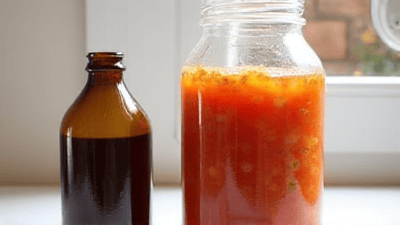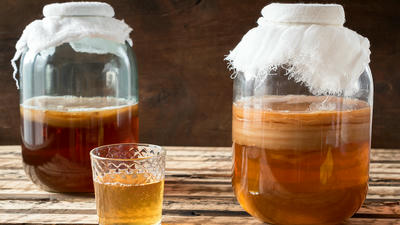
Fermentation is a magical process that transforms simple ingredients into tangy, delicious foods that are steeped in history and culture. Whether it’s the fizzy delight of kombucha or the savory crunch of kimchi, fermentation allows us to preserve food while also enhancing its nutritional value and flavor.
What is Fermentation?
Fermentation is a natural process that occurs when microorganisms like bacteria, yeast, and molds convert sugars and starches into acids, gases, or alcohol. This process not only helps preserve food but also contributes to its unique flavors and nutritional profile. For centuries, many cultures have harnessed the power of fermentation to create a wide array of food products, from bread and yogurt to pickles and cured meats.
The Health Benefits of Fermented Foods
Fermented foods are renowned for their numerous health benefits. Here are a few reasons why you might want to add kombucha and kimchi to your diet:
-
Probiotics: Fermented foods are rich in probiotics, the beneficial bacteria that help maintain a healthy gut microbiome. A balanced gut microbiome is crucial for digestion, nutrient absorption, and immune function.
-
Enhanced Nutrient Absorption: Fermentation can increase the bioavailability of certain nutrients, making it easier for your body to absorb vitamins and minerals such as B vitamins and vitamin K.
-
Improved Digestion: The probiotic content in fermented foods can aid in digestion, help alleviate bloating, and reduce the risk of digestive disorders.
-
Antioxidant Properties: Many fermented foods are high in antioxidants, which help combat oxidative stress and inflammation in the body.
-
Flavor and Variety: Fermentation brings unique and complex flavors to foods that can enhance your meals and encourage you to try new dishes.
Crafting Your Own Kombucha
Kombucha is a fizzy, fermented tea that has gained popularity in recent years for its health benefits and unique flavor. Making your own kombucha at home is an enjoyable and straightforward process. Here’s how to do it:
Ingredients
- 8 cups of water
- 1 cup of sugar (white or brown sugar works best)
- 8 bags of black or green tea (or 2 tablespoons of loose-leaf tea)
- 2 cups of starter tea (from a previous batch or store-bought kombucha)
- 1 SCOBY (Symbiotic Culture of Bacteria and Yeast)
- Optional: flavorings (like fruit, herbs, or spices)
Equipment Needed
- A large glass jar (at least 1-gallon capacity)
- A clean cloth or coffee filter
- A rubber band or string
- A wooden spoon
- Bottles for second fermentation (if flavoring)
Instructions
-
Prepare the Tea: Boil the water in a large pot. Once boiling, remove it from heat and add the sugar, stirring until it dissolves. Next, add the tea bags and let them steep for about 15 minutes. Remove the tea bags and let the mixture cool to room temperature.
-
Combine Ingredients: Once the tea is cooled, transfer it to the glass jar. Add the starter tea and gently place the SCOBY into the jar.
-
Cover and Ferment: Cover the jar with a clean cloth or coffee filter and secure it with a rubber band. This allows air to flow while keeping out dust and insects. Place the jar in a warm, dark place (around 68-85°F) and let it ferment for 7 to 14 days, depending on your taste preference.
-
Taste and Check: After about a week, start tasting your kombucha daily. Once it reaches a flavor you enjoy, it’s time for the next step.
-
Second Fermentation (Optional): If you want to add flavors, remove the SCOBY and set it aside. For flavoring, add pieces of fruit, herbs, or spices to the kombucha in bottles. Seal the bottles tightly and let them sit at room temperature for another 3 to 5 days to carbonate.
-
Refrigerate and Enjoy: After the second fermentation, refrigerate your flavored kombucha. Be cautious when opening, as it may be very fizzy! Enjoy your homemade kombucha as a refreshing beverage.
Tips for Successful Kombucha
- Always use clean utensils and containers to avoid contamination.
- If your SCOBY becomes discolored or develops an off smell, it may be best to discard it and start over.
- Vibrant flavors can be achieved by experimenting with different fruits and herbs during the second fermentation. Some popular options include ginger, berries, mint, or lemon.

Making Your Own Kimchi
Kimchi is a traditional Korean dish made from fermented vegetables, most commonly napa cabbage and radishes, seasoned with a mixture of spices. Kimchi is not only packed with flavor but is also a versatile ingredient that can enhance various dishes or be enjoyed on its own.
Ingredients
- 1 large napa cabbage
- 1/2 cup of sea salt
- Water (enough to soak the cabbage)
- 4 cloves of garlic, minced
- 1-inch piece of ginger, minced
- 1 tablespoon of sugar
- 1/4 cup of fish sauce (or soy sauce for a vegetarian option)
- 1/4 cup of Korean red chili pepper flakes (gochugaru, adjust according to taste)
- 4 green onions, chopped
- Optional: shredded carrots, daikon radish, or other vegetables
Equipment Needed
- A large bowl
- A clean jar for fermentation (make sure it is non-reactive, like glass or ceramic)
- A clean cloth or lid
Instructions
-
Prepare the Cabbage: Cut the napa cabbage in half lengthwise, and then cut each half into quarters. Rinse the cabbage pieces and place them in a large bowl. Dissolve the sea salt in water and pour it over the cabbage. Weight the cabbage down with a plate to keep it submerged, and let it soak for 1 to 2 hours.
-
Make the Kimchi Paste: In a separate bowl, mix the minced garlic, ginger, sugar, fish sauce, and gochugaru to create a paste. Adjust the amount of gochugaru to control the heat level.
-
Rinse and Mix: After salting the cabbage, thoroughly rinse it under cold water to remove excess salt. Drain well and combine the cabbage with the kimchi paste, mixing well to coat all the pieces. Add in chopped green onions and any additional vegetables you like.
-
Pack into Jar: Pack the coated cabbage mixture tightly into a clean jar, leaving about an inch of headspace at the top. Press down to remove air bubbles and to ensure that the liquid covers the vegetables.
-
Ferment: Cover the jar with a clean cloth or lid. Let it ferment at room temperature for 1 to 5 days, depending on your taste preference. After a day, start tasting it daily to determine when it has reached your desired flavor.
-
Store in Refrigerator: Once fermented to your liking, seal the jar with a tight lid and refrigerate. Kimchi continues to ferment slowly in the refrigerator, and its flavor will deepen over time.
Tips for Successful Kimchi
- Experiment with different vegetables. Traditional kimchi often includes radishes, but you can add other veggies, such as carrots or cucumbers.
- Customize the spice level according to your taste; gochugaru can vary in heat, so taste the paste before adding it to the cabbage.
- Always use clean utensils and containers to avoid contaminants.
Conclusion
Fermentation is an age-old technique that not only preserves food but also imparts unique flavors and health benefits. By crafting your own kombucha and kimchi at home, you can explore your culinary creativity while nourishing your body with probiotics and enzymes. Remember that fermentation is a process of trial and error, so don’t be discouraged if your first batch doesn’t turn out perfectly. Enjoy the journey of creating delicious, homemade fermented foods that can become staples in your kitchen. Happy fermenting!



